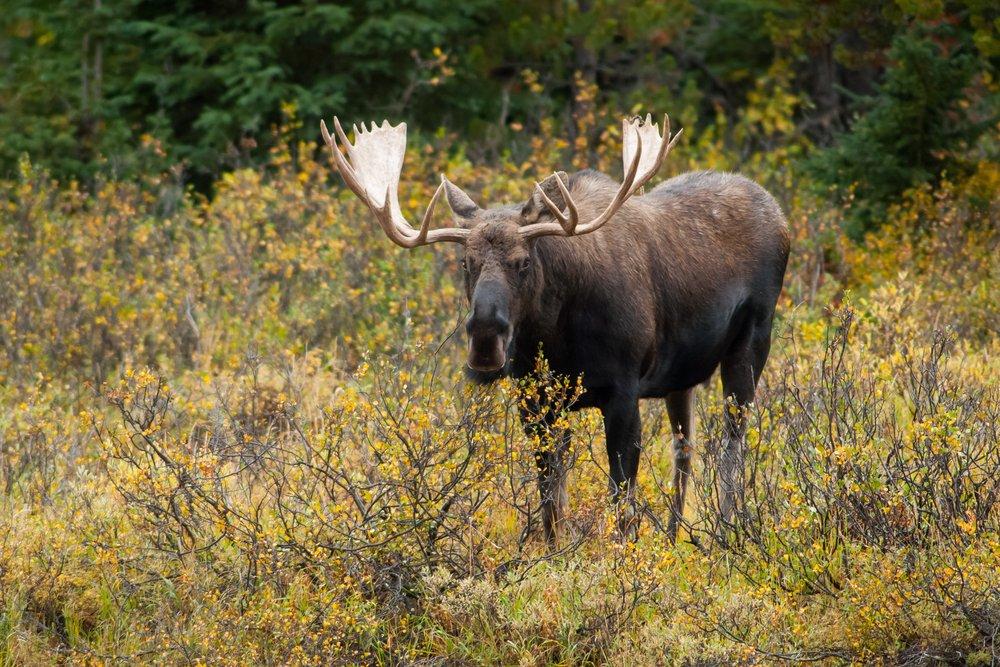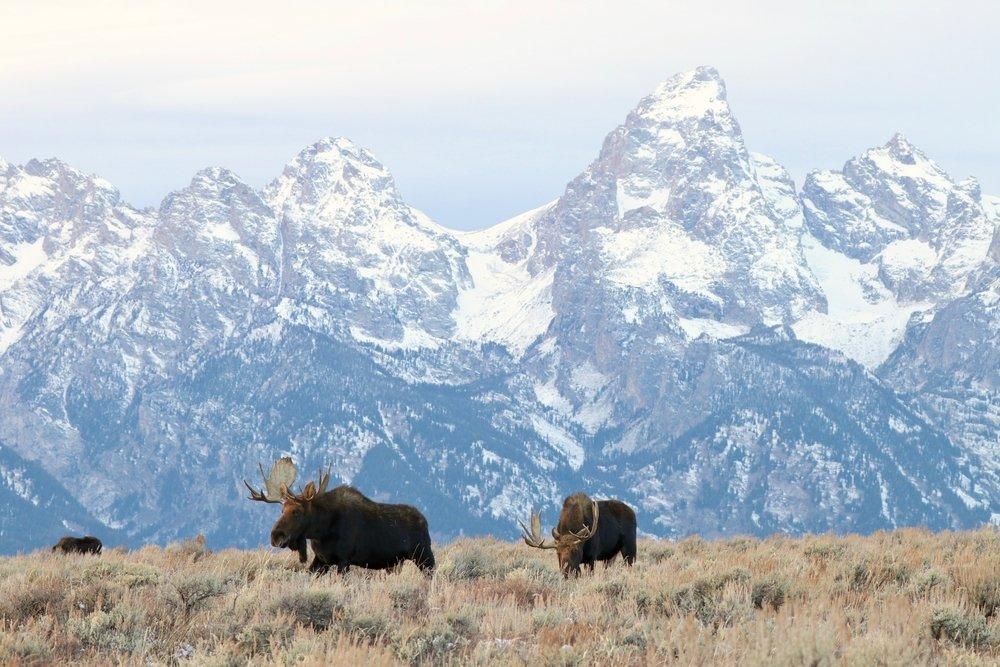Have You Ever Been on a Dangerous Hunt?
I'd been suckered back in — back to bowhunt moose in Southeast Alaska. I should've known better. I'd visited Southeast twice before. Some of the worst hunts of my life, though the second time I actually saw a couple bulls. I bowhunted somewhere else for moose before that, trudging through conspicuously clean, nightly refreshed snow for 10 days without cutting a single track. The portly, chain-smoking pilot from the major Anchorage air taxi service insisted I'd come up short due to a lack of skills. Okay Napoleon.
On the last trip I'd seen moose from the airplane while circling to slide into a desolate lake. The following morning I approached a decent bull, slipped within 32 yards. He was either barely legal, or barely not, meaning he was just at, or just short of the 50-inch legal minimum Alaska mandates for non-resident hunters. I passed. There was another bull, a behemoth, and I just flat screwed that up, and that's all I'll offer about that. Afterwards, the weather went to hell, a foregone conclusion in Southeast, and that was that.
The first trip to Southeast was the worst. A friend and I hunted two weeks as hard as we knew how and didn't see a single moose, or anything in the way of sign really. I've bowhunted all over, guided elk hunters in New Mexico 23 years, so you'll have to believe me when I tell you we hunted hard. I did kill a black bear with a recurve bow. There were some heated arguments afterwards about billable hours, a near fist fight, and I swore I'd never hunt Southeast again.
And then I did. And, of course, there I was still again. Yet, this time I believed.
You see, we saw a bull from the flivver, while circling into camp. A big bull, 60 inches or better, in a place our host, Charles Allen, knew how to get to — easily. Charles owns Alaska Expedition Company, a first-class fishing, waterfowling and hunting lodge on the Tsiu River (pronounced Sigh-You, a native term for place of wind), and also knives of Alaska. Regular hunting partner Ted Jaycox had roped me into this.
So there we were, believing we'd kill a moose.
We went in the following morning via a Go-Devil that pushed the aluminum skiff places I wouldn't have guessed possible. Trumpeter swans lifted from the still water with raucous slap-slap-slaps, waterfowl wheeled in tight knots from every cove, the sun coming over the Robinson Mountains first red, then orange and of a sudden, blinding yellow. Coho salmon swirled from every eddy, bulging water before them. The ocean maintained a dull roar in the middle distance across still air.
We hiked up an open valley when the Go-Devil could go no further, cut out a rearing Sitka spruce for a vantage, scraped and beat trees with a moose scapula to imitate rutting bull antlers on wood or battling for a cow, produced cow moans with nose pinched tight and hands cupped, drawn out long and sadly. We lingered in the area 2 hours, and then moved on — to the next suitable tree.
This business of climbing trees as glassing perches wasn't new to me. It'd come to me on my first moose hunt, and I thought I was quite a clever fellow. Turns out every moose hunter in Alaska knows the drill: Find the biggest spruce in the area. Begin climbing, saw in hand, tunneling through constricting boughs. Once on top the saw is used to open a vantage. It's then a matter of going to work with binoculars. In a flat world of dog-hair-thick red and Sitka alder, Sitka willow, this is how you find moose. This is how you're supposed to find moose.
I cut out and climbed three such trees that first day. At the tops I was 60 to 70 feet up, could see the angry Pacific maybe 20 miles away, in the opposite direction 18,000-foot Mount Saint Elias staunch and regal, smaller ranges layered one on the next. The Chugach, Wrangell-Saint Elias, Granite Range, Bagley Ice Field, Robinson Mountains, stretched out east and west as far as the eye could discern, white capped, spilling glaciers from their flanks, willow and alder and poplar crowding the bases to create a Braeburn apple patchwork of color between darker spruces. A brisk breeze rose, harbinger of a promised monster storm. It was hard to imagine, stillness in alders below encouraging ravenous whitesox flies to gnaw exposed flesh.
Rob, one of Charles' young salmon guides (brought along for muscle), and I sat atop adjacent spruce for several hours, watching various sectors of a wide, mostly open meadow. We expected our bull to appear, as this was the direction he and his cow seemed to be pointed, nearly 16 hours earlier.
The day didn't go as planned. I was moose hunting, after all.
We gathered gear and slogged toward the skiff, clouds scudding in hurriedly, wind picking up, rain arriving in spurts. The inevitable weather had arrived. We picked our ways carefully, peeking into finger meadows, watching for dark shapes or glowing antler palms. By the time we reached the boat, real weather had pulled in, sprinkling the water surface like raising trout, wind pushing tree tops around, burnishing the protected marsh. In the boat we backtracked, landing occasionally to inspect open meadows.
The wind whipped, rain stinging our faces. Charles turned up one last creek before heading in for shelter and food. The Go-Devil pushed up the tight waterway, over sunken logs and gravel bars. The motor cut suddenly.
Charles pointed, "You have binoculars handy? Check that out for me."
Where he gestured there was a dark spot. A small spruce. I panned slowly and miraculously discovered a barely visible moose. I peered longer and made out antlers. The bull was in chest-high alders, feeding, the wind carrying our noise away from him safely. I watched him longer and called him a shooter. There was no doubt.
"Everyone hunker down and we'll swing around this bend and move closer," Charles said. The bull was a mile away across treacherous marsh.
The skiff hung several times and we jumped over the sides and pushed it and clambered in when we were underway again. We seemed to travel a good distance and I was growing impatient. I wanted badly to start.
We tied off and fought clutching alder, breaking into open marsh, knee-deep shrub, the occasional spruce cluster. The bull was nowhere in sight. He'd vanished; not so inconceivable considering the ocean of head-high alder beyond. I wanted to charge in, hoping for the best. Charles suggested we wait, opting to play it safe.
"He just might wander back out," Charles urged. "If he doesn't, he'll be here tomorrow." So we waited while the weather deteriorated, darkness and cold creeping in.
A cow and calf pair broke out of the alders to our right. They were fleeing something, perhaps a brown bear, or our bull. We could only guess. They crossed our bow at 80 yards, running past and pausing 150 yards to our left. They seemed to be sniffing the breeze.
Charles began thrashing brush with his scapula. I pinched my nose with opposing thumbs and produced deep grunts through cupped hands, exaggerated calls meant to cheat the wind. We watched the brush carefully where the cow and calf had paused to sniff. Rob tapped Charles' shoulder.
"Isn't that the moose?" Rob asked simply, pointing straight downwind.
Charles snatched my recurve bow away and thrust a .270 into my hands. I didn't argue. We looked him over, first in disagreement about his legality, then agreeing completely. We ducked and moved toward him, then rushed left, afraid he'd receive our scent. Abruptly he cleared brush. I thumbed back the hammer. He stopped broadside, 200 yards away. I shot offhand. Somehow I was surprised by the miss. The bull didn't flinch. In fact, he took a few steps and began thrashing brush. Charles produced a cow moan to keep him interested.
I dashed 60 yards ahead and found a spruce trunk. I leaned against it but the bull was in the brush, antlers showing above alder, tilting closer. I thumbed the hammer, the scope rained in, fogged badly. I saw movement, a general blob wearing blurry antlers.
He reached maybe 150 yards but was beginning to grow nervous.
I centered him in the scope and tried the trigger again. He dropped from sight in waist-high alders and we ran to him in the gathering dusk, anxious to see him up close.
He was 54 inches wide but very high, heavily palmed, paddles ragged with long, thick tines. We had little time to admire him. Rain was coming down in earnest, our light going quickly. Ted shot some quick video footage, a few hasty stills and Charles produced his Knives of Alaska Super Pro-Pack, a three-knife set plus bone saw and hatchet and diamond sharpening steel, designed specifically for the arduous task of reducing a three-quarter-ton beast to meat.
The weather descended like a locust plague. A quick decision was made. Charles would make the run to camp for more muscle and pack boards. Ted, Rob and I continued on the moose.
The hunt was over, but the real adventure had begun.
Charles returned a couple hours later with three more young men. The rain pounded, the wind making it difficult to walk a straight line. It was black dark. The moose was now a pile of quartered meat, and it was difficult to forget we were surrounded by some of the most aggressive brown bears in Alaska. The skiff was moored 250 yards from the piled moose meat. In an hour we would be loaded. We were forced to bodily push the laden boat down the narrow, shallow creek, a good mile of slogging and shouldering into the reluctant skiff. At the creek mouth seven grown men clambered atop maybe 750 pounds of moose meat, hide and antlers.
The 18-foot skiff was dangerously overloaded, but leaving people behind was not an option, as the weather had become life-threatening. Welcome to Alaska.
We hit the shallow, open water of the marsh and whitecaps began hitting us side-on, the boat taking on water. All of us scrambled to the downwind side to create additional freeboard. Charles eased the skiff into the black beyond, yelling directions over the cutting wind for the bright headlight secured over my hood. I'd just installed fresh batteries and was thankful for that. Everything else we owned seemed to be dying.
I've no idea how Charles found his way out of that marsh. Rain was slanting horizontally across my headlight, driving like darts into the side of my face. Visibility was limited to 15 yards as we weaved through spooky channels and more open stretches of whitecaps. The boat had grown unresponsive, the bottom filled with water. It seemed to go on forever. My fingers had long turned numb. My body ached from wrestling the bull. It had ceased being exciting. It'd long become something simply to be endured. Even the youngsters had grown quiet. And then Charles somehow discovered land and the Jeep.
The meat was transferred from the boat to the hitched trailer, the boat stashed, everyone wedging into the tiny Jeep. Sand blew like white-out snow before a 60 mph-plus wind, rain washing the windscreen. In time, the man who'd navigated through trackless, endless swamp lost his way. The situation had grown tense by the time the lights of the lodge finally pierced the gloom, slowly looming more brightly.
Shelter, dry clothes, food, drink. It'd been a long day Southeast. An Alaskan day.
Don't Miss: Crazy Moose Encounter Video
Editor's Note: This was originally published February 20, 2009.
Are you a big game hunter wanting to learn how to accomplish your goals? Check out our stories, videos and hard-hitting how-to's on big game hunting.








